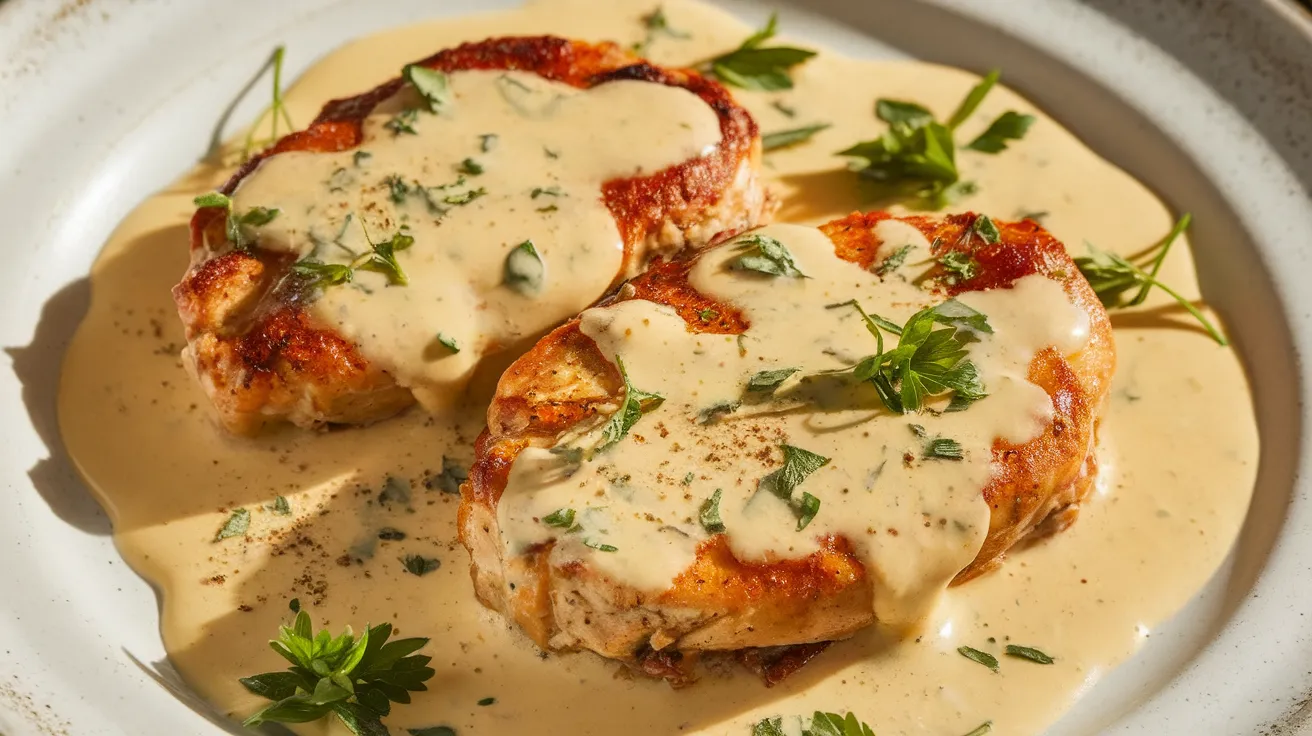This rich and velvety sauce for chicken cordon bleu elevates your homemade dinner to gourmet status with minimal effort. Our step-by-step guide ensures perfect results every time, creating a luxurious cream sauce that perfectly complements the classic ham and Swiss flavors. This sauce for chicken cordon bleu recipe uses simple pantry ingredients to deliver restaurant-quality taste that will impress your family and guests alike.
SERVES: 4 | PREP: 15 MIN | COOK: 10 MIN | TOTAL: 25 MIN
Ingredients
For the Base Sauce
| Ingredient | Amount |
|---|---|
| Butter | 3 tablespoons |
| All-purpose flour | 3 tablespoons |
| Chicken broth | 1 cup |
| Heavy cream | ½ cup |
| Dijon mustard | 2 tablespoons |
| White wine | ¼ cup |
For the Flavor Boost
| Ingredient | Amount |
|---|---|
| Swiss cheese, grated | ½ cup |
| Fresh thyme | 1 teaspoon |
| Garlic powder | ½ teaspoon |
| Salt | To taste |
| Black pepper | ¼ teaspoon |
| Fresh parsley | 2 tablespoons, chopped |
Complete Step-by-Step Instructions
Phase 1: Preparing Your Workspace (2 minutes)
1. Set up your cooking station: Place all ingredients within arm’s reach of your stove. Measure everything into small bowls before you start cooking. This French technique called “mise en place” prevents mistakes and ensures smooth cooking.
Why this matters: Sauce-making happens quickly, and you won’t have time to measure ingredients once you start. Having everything ready prevents the butter from burning while you scramble for the flour.
2. Test your whisk: Make sure your whisk moves freely in your saucepan. If it’s too big, it won’t reach the pan corners where lumps hide. A balloon whisk works best for this sauce for chicken cordon bleu recipe.
Safety tip: Keep a damp kitchen towel nearby to wipe spoon handles – they get slippery with butter and cream.
Phase 2: Creating the Perfect Roux Base (5 minutes)
3. Heat your pan correctly: Place your medium saucepan over medium heat for 30 seconds before adding butter. The pan should feel warm when you hold your hand 2 inches above it.
Why medium heat: High heat burns butter and creates bitter flavors. Low heat won’t activate the flour properly, leading to a raw taste in your finished sauce.
4. Melt butter with precision: Add 3 tablespoons butter to the warmed pan. Watch for gentle, even bubbling across the surface – this means your temperature is perfect. The butter should melt completely in 60-90 seconds.
Visual cue: Properly melted butter looks clear and golden, not foamy or brown. If you see brown bits, your heat is too high – start over with fresh butter.
5. Add flour immediately: The moment your butter stops bubbling, sprinkle 3 tablespoons flour evenly across the melted butter. Don’t dump it in one spot – this creates lumps that are hard to remove.
Technique tip: Some chefs sift flour directly into the pan for ultra-smooth results. Try this if you’re having lump problems.
6. Whisk continuously for 2 full minutes: Start whisking the second flour hits the butter. Use rapid, circular motions, reaching every corner of the pan. Your arm will get tired – this is normal and necessary.
What you’re looking for: The mixture should look like wet sand initially, then gradually smooth out. After 2 minutes, it should be completely smooth and smell nutty, not floury.
Troubleshooting: If you see lumps forming, whisk more vigorously and press them against the pan sides. Small lumps will dissolve with persistent whisking.
Phase 3: Building the Liquid Foundation (4 minutes)
7. Add wine for deglazing: Pour ¼ cup white wine into the pan while whisking constantly. The mixture will bubble dramatically and may even steam – this is perfect! The alcohol cooks off while adding crucial flavor depth.
Wine substitute: No wine? Use ¼ cup chicken broth plus 1 teaspoon lemon juice instead. The acidity mimics wine’s flavor contribution.
Safety note: Keep your face away from the pan when adding wine – the steam can be hot and the alcohol vapors strong.
8. Gradually incorporate chicken broth: Add 1 cup chicken broth in three separate pours: ⅓ cup, then ⅓ cup, then the final ⅓ cup. Whisk vigorously after each addition before adding the next portion.
Why gradual addition matters: Dumping all the broth at once can create lumps that never dissolve. The gradual method ensures silky smoothness in your sauce for chicken cordon bleu.
Visual guide: After each addition, the mixture should look completely smooth before you add more liquid. Take your time – rushing here ruins the final texture.
9. Achieve the perfect simmer: Increase heat to medium-high and bring the mixture to a gentle simmer. You’ll see small bubbles forming around the edges of the pan, not a rolling boil in the center.
Temperature check: The mixture should register 180-185°F on an instant-read thermometer. This temperature thickens the sauce without scorching.
Phase 4: Adding Richness and Creaminess (2 minutes)
10. Reduce heat before adding cream: Turn heat to low immediately when you see simmering. This is crucial – high heat curdles cream and ruins your sauce for chicken cordon bleu.
Temperature safety: Let the mixture cool for 30 seconds before adding cream. The bubbling should completely stop.
11. Stream in heavy cream slowly: Pour ½ cup heavy cream in a thin, steady stream while whisking continuously. Take 30-45 seconds to add all the cream – never dump it in quickly.
Pro technique: Hold the cream container 6 inches above the pan for better control. Some chefs temper the cream by adding 2 tablespoons of the hot mixture to the cream first, then adding everything back.
Visual cue: The sauce should turn a beautiful pale yellow color and smell rich and creamy. If you see any curdling (small white clumps), remove from heat immediately and whisk vigorously.
Phase 5: Flavor Development (2 minutes)
12. Incorporate mustard properly: Add 2 tablespoons Dijon mustard and whisk until completely dissolved. Good mustard adds both flavor and helps emulsify the sauce, making it more stable.
Mustard quality matters: Use real Dijon mustard, not yellow mustard. The wine and herbs in Dijon complement the classic cordon bleu flavor profile perfectly.
13. Season with herbs and spices: Sprinkle in 1 teaspoon fresh thyme, ½ teaspoon garlic powder, ¼ teaspoon black pepper, and ¼ teaspoon salt. Whisk to distribute evenly.
Fresh vs. dried thyme: Fresh thyme adds bright flavor, but you can substitute with ⅓ teaspoon dried thyme if needed. Add dried herbs earlier in the cooking process for better flavor development.
Salt timing: Start with less salt than you think you need – you can always add more, but you can’t take it away. The chicken broth and cheese both add sodium.
14. Taste and adjust seasoning: Use a clean spoon to taste your sauce. It should be creamy, tangy from the mustard, and well-balanced. Adjust salt, pepper, or mustard as needed.
Phase 6: Final Cheese Integration (1 minute)
15. Remove from heat completely: Turn off the burner and move the pan to a cool burner if possible. The residual heat will melt the cheese perfectly without making it stringy or grainy.
Why off-heat matters: Direct heat can cause cheese proteins to seize up, creating a grainy texture that can’t be fixed.
16. Add cheese gradually: Sprinkle ½ cup freshly grated Swiss cheese into the sauce in three additions, whisking gently after each addition until completely melted and smooth.
Cheese grating tip: Grate your own Swiss cheese from a block. Pre-shredded cheese contains anti-caking agents that prevent smooth melting and can make your sauce for chicken cordon bleu grainy.
Texture check: The finished sauce should coat the back of a spoon but still pour easily. If it’s too thick, whisk in 1-2 tablespoons of warm chicken broth.
Phase 7: Final Garnish and Presentation (1 minute)
17. Add fresh herbs last: Stir in 2 tablespoons freshly chopped parsley just before serving. Fresh herbs lose their bright color and flavor when cooked too long.
Herb alternatives: Try fresh chives, tarragon, or a combination for different flavor profiles. Avoid dried parsley – it adds no flavor value.
18. Optional straining for perfection: For restaurant-quality smoothness, strain your sauce through a fine-mesh sieve into a clean container. This removes any remaining lumps or herb pieces for an ultra-silky sauce for chicken cordon bleu.
19. Serve immediately: This sauce tastes best when served warm and fresh. If you need to hold it, cover the surface directly with plastic wrap to prevent a skin from forming.
Temperature holding: Keep finished sauce warm in a double boiler or very low heat, stirring occasionally. Never let it boil after completion.
Chef’s Notes for Perfect Sauce for Chicken Cordon Bleu
• Temperature Control is Everything: The key to perfect sauce for chicken cordon bleu lies in temperature management. Keep heat at medium for the roux, reduce to low for cream additions, and remove from heat entirely for cheese.
• Timing Your Sauce: Start this sauce when your chicken has 10 minutes left to cook. Fresh sauce always tastes better than reheated, and the timing works perfectly with most cordon bleu recipes.
• Wine Selection Matters: Use a dry white wine you’d actually drink – cooking wine often contains salt and preservatives that affect the final flavor. Chardonnay, Sauvignon Blanc, or Pinot Grigio all work beautifully.
• Storage Success: This sauce for chicken cordon bleu keeps in the refrigerator for up to 4 days. Reheat gently over low heat, whisking frequently, and thin with broth if needed.
Nutrition Information (Per Serving)
- Calories: 185
- Protein: 6g
- Carbohydrates: 8g
- Fat: 14g
- Sodium: 420mg
- Calcium: 15% DV (from Swiss cheese)
Creative Variations for Your Sauce
Classic French Herb Sauce
Enhance your sauce for chicken cordon bleu with 1 tablespoon fresh chopped rosemary and 1 teaspoon dried herbes de Provence. This aromatic version pairs wonderfully with our sauce for baked chicken techniques for a complete French-inspired meal.
Mushroom Swiss Enhancement
Sauté 1 cup sliced button mushrooms in butter before starting your roux. The earthy mushroom flavor adds depth and makes the sauce heartier. Perfect for mushroom lovers who want extra umami in their sauce.
Lighter Health-Conscious Version
Replace heavy cream with ½ cup half-and-half and reduce butter to 2 tablespoons. Add 2 tablespoons Greek yogurt at the end for tanginess. This cuts 40 calories per serving while maintaining creamy texture.
Spicy Swiss Kick
Add ¼ teaspoon cayenne pepper and 1 tablespoon whole grain mustard for heat lovers. This variation works exceptionally well with our sauce for chicken meatballs recipe when you want bold flavors.
Storage & Reheating Your Sauce for Chicken Cordon Bleu
Immediate Storage: Transfer leftover sauce to an airtight container while still warm. Press plastic wrap directly onto the surface to prevent skin formation. Cool completely before refrigerating.
Refrigerator Life: Properly stored sauce lasts 4-5 days. The sauce will thicken considerably when cold – this is completely normal and expected.
Gentle Reheating Method: Warm sauce in a heavy-bottomed saucepan over low heat, whisking every 30 seconds. Add warm chicken broth 1 tablespoon at a time to restore original consistency.
Microwave Alternative: Heat in 30-second intervals at 50% power, stirring between each interval. Never microwave at full power – it can cause separation.
Freezing Guidelines: This sauce freezes for up to 2 months in freezer-safe containers. Thaw overnight in refrigerator, then reheat slowly while whisking to restore smoothness.

Troubleshooting Common Sauce Problems
Problem: Lumpy, Grainy Texture
Detailed Solution: Stop cooking immediately and strain the sauce through a fine-mesh sieve into a clean pan. For stubborn lumps, use an immersion blender for 10-15 seconds. Prevention: Always whisk constantly when adding flour and liquids to your roux base.
Problem: Sauce Too Thick or Gluey
Detailed Solution: The sauce thickened too much during cooking. Remove from heat and gradually whisk in warm chicken broth, 1 tablespoon at a time, until you reach desired consistency. Test by coating the back of a spoon – it should flow off slowly but steadily.
Problem: Broken or Separated Sauce
Detailed Solution: This happens when cream overheats or cheese is added at too high temperature. Remove from heat immediately and whisk in 1 tablespoon cold butter to re-emulsify. If this doesn’t work, start over with a fresh roux and gradually whisk the broken sauce into it.
Problem: Overly Salty Taste
Detailed Solution: Balance excess salt by adding 1 teaspoon sugar and 2 tablespoons additional heavy cream. Taste and repeat if necessary. For severe over-salting, double the recipe without adding more salt, then combine the batches.
Problem: Bland, Flavorless Result
Detailed Solution: Boost flavor with additional Dijon mustard (1 teaspoon at a time), a squeeze of fresh lemon juice, or a pinch more thyme. Season gradually and taste after each addition. Sometimes the issue is under-seasoning rather than poor technique.
Problem: Skin Forming on Surface
Detailed Solution: This happens when sauce sits uncovered. Whisk the skin back in if it’s thin, or strain it out if it’s thick. Prevent by covering the surface directly with plastic wrap when storing or holding the sauce.
Essential Equipment for Perfect Results
Primary Equipment:
- Medium saucepan (2-3 quart capacity) – Heavy-bottomed pans distribute heat evenly
- Balloon whisk – The curved wires reach pan corners better than straight whisks
- Liquid measuring cup – For accurate liquid measurements
- Dry measuring cups and spoons – Level measurements ensure consistent results
Helpful Additions:
- Fine-mesh strainer – Creates restaurant-quality smoothness
- Instant-read thermometer – Takes guesswork out of temperature control
- Silicone spatula – Perfect for scraping pan sides clean
- Small prep bowls – Keep ingredients organized and ready
Complete Shopping List by Store Section
Dairy Department
- Butter (1 stick minimum)
- Heavy cream (1 pint container)
- Swiss cheese block (8 oz for grating)
Pantry Staples
- All-purpose flour
- Chicken broth (32 oz carton)
- Dijon mustard (quality brand recommended)
- Garlic powder
- Salt and black pepper
Wine Section
- Dry white wine (Chardonnay or Sauvignon Blanc)
Fresh Produce
- Fresh thyme (small package)
- Fresh parsley (flat-leaf preferred)
Money-Saving Tip: Buy wine in airline bottles if you only need it for cooking. This prevents waste and saves money compared to full bottles.
Five Success Secrets for Perfect Sauce
1. Temperature Management is Critical: Use medium heat for roux building, low heat after adding cream, and off-heat for cheese incorporation. Most sauce failures come from temperature mistakes, not technique errors.
2. Fresh Ingredients Make the Difference: Grate your own Swiss cheese, use fresh herbs when possible, and choose quality Dijon mustard. These small upgrades dramatically improve your final sauce for chicken cordon bleu.
3. Patience with the Process: Never rush the roux development or liquid incorporation stages. Taking an extra minute at each step prevents hours of frustration trying to fix problems later.
4. Constant Motion Prevents Problems: Keep whisking throughout the cooking process. Your arm may get tired, but consistent movement prevents lumps, scorching, and separation issues that ruin the final result.
5. Taste and Adjust Throughout: Season gradually and taste frequently during cooking. Building flavors in layers creates the most balanced and delicious sauce for chicken cordon bleu that your family will request again and again.
This comprehensive sauce for chicken cordon bleu recipe ensures perfect results every time, even for complete beginners. The detailed instructions and troubleshooting guide give you the confidence to create restaurant-quality sauce at home with simple ingredients and basic techniques.




